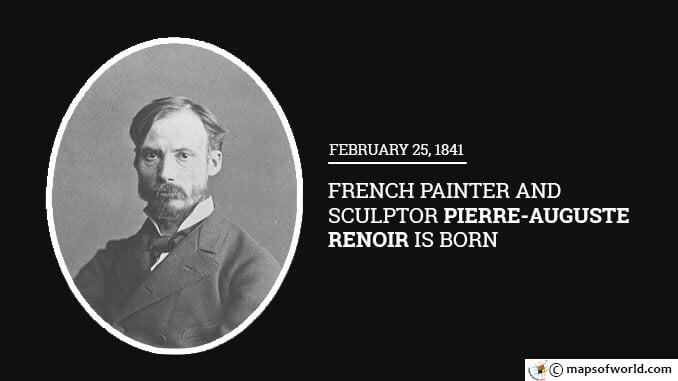Pierre-Auguste Renoir, one of the pioneering Impressionist painters, was born on February 25, 1841, in Limoges of the Haute-Vienne region in France. Renoir’s parents were poor but very artistic in their work – his father was a tailor and his mother a seamstress. He was the last of their four surviving children. Soon after his birth, the family moved to Paris, and went to live near the Louvre one of the world’s largest museums which also houses a spectacular art collection. Renoir went to work when he was barely into his teens and started his career as an apprentice to a porcelain painter. The work taught him skills that would later catapult him to fame – appreciation of designs, mixing colors, and decorative art. Within a few years, Renoir was ready to give up working as a porcelain painter and take up drawing classes at an art school run by sculptor Louis-Denis Caillouette, the renowned sculptor. Coming from a rather poor background, Renoir chose the class at the best free art school in the city. Soon, he decided to learn by imitation. His proximity to the Louvre came in handy – Renoir started to copy many of the masterpieces on display there. By the time he was 21, he had the makings of a great artist. Renoir was accepted to study under the renowned Swiss artist Marc Gabriel Charles Gleyre – this period would not only shape his artistic techniques but also provide him with his dearest friends. At Gleyre’s studio, Renoir met and befriended three artists – Claude Monet, Frédéric Bazille, and Alfred Sisleywho, who would go on to find the Impressionist school with him . Monet further introduced him to the likes of Camille Pissarro and Paul Cézanne. In 1864, Renoir’s painting, “La Esmeralda” gained admittance into the Paris Salon – the annual official art exhibit of the Académie des Beaux-Arts. The following year, again, he displayed a portrait of William Sisley at the Salon. The Salon’s censorship, however coveted, was much grudged by young Renoir. His financial woes, though, were far from over. Renoir struggled much at this time, often undertaking to paint portraits for a commission and staying at the homes of friends. By 1869, Renoir teamed up with Monet and started to spend time painting outdoors – very frequently on the banks of River Seine. During this period Renoir and Monet developed Impressionism – the famous technique that showcased bold, short brushstrokes, use of bright, vivid hues combined out a palette of primary colors alone. Renoir was drafted into the army in 1870 and prepared to defend France in the country’s war against Germany. He soon fell ill and was not assigned to any action. The war ended in 1871, and Renoir resumed his art work. Renoir was impressed by the natural scenes of France and everyday life. Among other themes, a number of his Impressionistic works showcase outdoor scenes, women bathing, or people dancing. The display of light and the movement of the objects were captured vividly and spontaneously in his works. The Bal au Moulin de la Galette is one of best known Impressionist paintings and a perfect example of his technique. Along with Pissarro, Monet, Cézanne and Edgar Degas, Renoir hosted the first Impressionistic exhibition in Paris in 1874. The Impressionists showcased their works in what they called “Salon des Refuses”, or the show of the refused artists. At this time, Renoir started to attract many wealthy patrons and good commissions. Georges Charpentier and his wife Marguérite, patronized and popularized him. In 1878, the Paris Salon once again featured his painting “Madame Charpentier and her Children,” and brought him much appreciation. Through the 1880s Renoir seemed to almost abandon his Impressionistic technique and took to painting many classical works. These added to his fame and stature in the art world. Renoir married Aline Charigot in 1890. The couple had three sons -, Pierre, Jean, and Claude. His wife and children were the inspiration for a number of his paintings. In the mid-1890s Renoir first started to suffer from rheumatism but continued to paint. In his later years, Renoir was affected greatly by the disease and partnered with a number of young artists. In 1912, he suffered from a debilitating stroke. Renoir died in December, 1919, at his residence in Cagnes-sur-Mer, France, leaving behind a legacy that artists would take inspiration from in the years to come. You may also like : February 25 1986 – The People Power Revolution Forces President Ferdinand Marcos to Flee the Philippines February 25, 1964 – Cassius Clay defeats Sonny Liston
February 25 1841 – French painter and sculptor Pierre-Auguste Renoir is born
Pierre-Auguste Renoir, one of the pioneering Impressionist painters, was born on February 25, 1841, in Limoges of the Haute-Vienne region in France. Renoir’s parents were poor but very artistic in…
505
